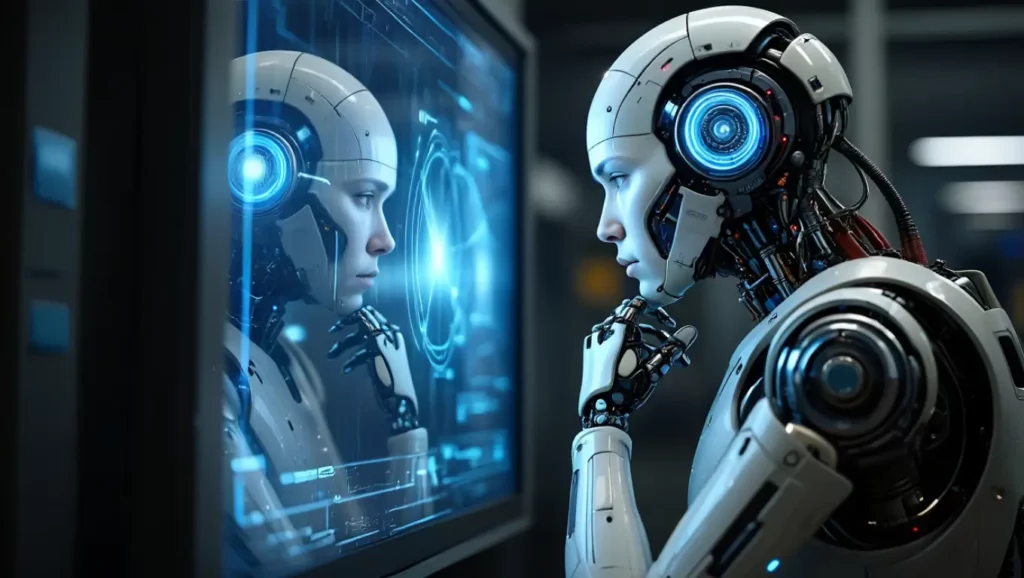Amidst the pouring rain in Hangzhou, Deep Robotics’ DR02 robot walks unfazed. Standing at 1.75 meters tall and capable of operating in temperatures ranging from -20 to +55 °C, it represents a significant advancement for China: transitioning from the laboratory to the large-scale industrialization of humanoid robots. The vision is clear: by 2045, to place a humanoid robot in every Chinese household, bolstered by colossal investments and an ultra-connected ecosystem.
China Industrializes Humanoids at Unmatched Speed with an Already Operational Ecosystem
In Wuhu, the Mornine robot from AiMOGA Robotics independently conducted a multilingual presentation at the 2025 Chery Global Innovation Conference. It simulated a complete customer journey in a car dealership: welcome, delicate object handling, precise navigation. This scenario no longer belongs to the realm of science fiction: the humanoid robot is entering our daily lives.
That same week, the Canton Fair hosted 46 robotic companies, attracting over 207,000 international buyers. Among them, Unitree Robotics embodies China’s industrial rise. Backed by Alibaba, Tencent, and Geely, the firm aims for a public offering valued at 50 billion yuan. Its humanoid H2 can fold laundry as well as navigate industrial environments.
Other players are not far behind. AheadForm focuses on emotion with its Elf V1, equipped with 30 facial muscles and a bionic skin. Kepler Robotics is producing the K2 “Bumblebee” humanoid in mass, priced at $34,000, featuring an energy efficiency of 81%. Several thousand units have already been ordered.
Stated Goals: 100 Million Robots by 2045 and an Aggressive Industrial Strategy
Beijing has clearly identified humanoid robotics as a key national strategic sector. The state is injecting 170 billion yuan into the industry, and public orders have surged, skyrocketing from 4.7 to 214 million units in just one year.
Projections forecast a market worth 300 billion yuan by 2035. By 2045, over 100 million robots could be deployed in households, businesses, and public services.
Unlike the United States, where Tesla focuses on advanced integrated AI, China bets on speed, continuous improvement, and mass production. It has a crucial advantage: a complete industrial ecosystem, from sensors to manufacturing.
China Aims to Establish Its Global Vision for Personal Robotics: A Humanoid for Everyday Life
This model pursues a straightforward goal: to integrate humanoids into daily activities, providing assistance in domestic chores, customer reception, education, healthcare, or logistics. With humanoids becoming increasingly accessible, expressive, and adaptable, China aims to become the world’s leading supplier of personal robotics.
This ambition is underpinned by a unique productive model: reducing innovation cycles, conducting real-world tests, and continuously improving. While others are still designing prototypes, Chinese manufacturers are already delivering initial units.
Like the documentary series Robots by Arte, China believes we will quickly acclimate to having a humanoid in our living rooms. And it seeks to be the first to stock it on store shelves.
Key Ingredients for China’s Success
- A clear and massive state strategy support
- Aligned public and private funding
- The capability for mass production at low costs
- Prototypes tested in real environments
- A rapid iteration culture inspired by software development
China Could Surpass Everyone in Personal Robotics
The global competition surrounding humanoids is intensifying. However, due to its strategy based on scale, speed, and vertical integration, China could become the first nation to make personal robots mainstream.
In 20 years, the scenario where every household harbors a useful, affordable, and cherished humanoid will no longer seem utopian. And what if this robot inevitably comes from China?




